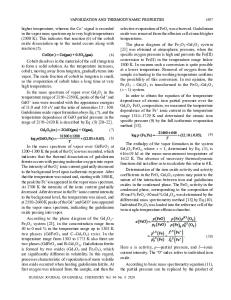Dry Etching to form Submicron Features in CMR Oxides: (Pr,Ba,Ca)MnO 3 and (La,Sr)MnO 3
- PDF / 1,440,161 Bytes
- 6 Pages / 417.6 x 639 pts Page_size
- 70 Downloads / 362 Views
R. K. Singh, P. H. Hogan*,
* Department of Materials Science and Engineering, University of Florida,
Gainesville FL
32611
** Center for Materials Research and Technology, MARTECH, Florida State University,
Tallahassee FL 32306 (1)* Present address : Department of Chemical Engineering and Technology, Chonbuk National University, Chonju 561-756, Korea ABSTRACT Effective pattern transfer into (Pr,Ba,Ca)MnO 3 and (La,Sr)MnO 3 has been achieved using C12/Ar discharges operated under Inductively Coupled Plasma conditions. Etch rates up to 900 A-min-' for (La,Sr)MnO 3 and 300 A-min' for (Pr,Ba,Ca)MnO 3 were obtained, with these rates being a strong function of ion flux, ion energy and ion-to-neutral ratio. The etching is still physically-dominated under all conditions, leading to significant surface smoothing on initially rough samples. Sub-micron (0.35 lrm) features have been produced in both materials using SiN, as the mask. INTRODUCTION It has long been known that bulk ceramic and single-crystal specimens of hole-doped manganites of the basic perovskite structure La, ,MMnO3 (where M is typically Ba,Sr,Ca or Pb) show a large magnetoresistance (MR) [1,21. The subsequent discovery of a large roomtemperature MR in thin films of doped manganate perovskite opened up the possibility of applications in read heads for hard disk drives, sensors and magnetic random access memories (MRAM) [3]. This was followed by the reports of a very large negative MR at 77 K in thin film
Lao 3 67Cao.33MnO 3, termed colossal magnetoresistance (CMR) [4,5]. Currently most efforts are focussed on obtaining high MR ratios at lower magnetic fields than in the original reports (6T)
and at higher temperatures [6-14]. Chemical substitution on the trivalent site is observed to improve MR behavior, since interatomic distance influences the magnetic-exchange interactions
between the cations [15-17]. Therefore, Nd-and Pr-based manganites are expected to show improved MR behavior relative to La-based compounds [18]. In addition large MR values have been achieved in LaMMnO,/ SrTiO3/ LaMMnO 3 trilayers (M=Ca or Sr) at low fields [19].
To fabricate spin-valve read heads or MRAM elements it is necessary to develop pattern transfer processes for the manganites. In conventional NiFe-based giant magnetoresistance materials, the patterning is generally performed by ion beam milling because of the relatively low volatility of metal halide etch products. We have previously reported that C12/Ar discharges operated under high density plasma conditions can provide practical etch rates for NiFe and related materials [20,21]. Very little work has been performed in the CMR materials. In (La,Ca)MnO 3 we found that iodine and bromine plasma chemistries proved some degree of chemical enhancement in the etch mechanism. In this paper we report an investigation into Inductively Coupled Plasma (ICP) dry etching of (Pr,Ba,Ca)MnO 3 and (La,Sr)MnO 3 in C12/Ar discharges. Maximum etch rates of 350 and 900 341 Mat. Res. Soc. Symp. Proc. Vol. 574 © 1999 Materials Research Socie
Data Loading...










